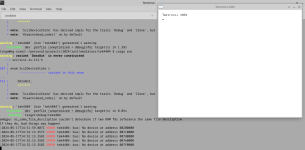Elektraglide
Experienced Member
Iv'e decided to write a Tektronix 4404 emulator so everyone can experience Smalltalk-80 on a 68010.
I've started with Brad Parkers amazing sun2 emulator as its 68010, b/w display, MMU. So roughly similar, but much more sophisticated than tek4404.
So far the emulator starts (yay), prints some diagnostics:
Pegasus
% Adr: 00
..and tests memory, tests ACIA and DUART, clears the MMU pte and now its ready to start the SCSI disk.
I see it writing some 1 byte commands in order:
cmd=0 => disassembly of the boot rom shows it expects 0x80 reply to continue
cmd=1 => ??
cmd=255 => disassembly of the boot rom shows its expecting this to do an IRQ_3. I have no idea why.
While I have been writing low level stuff for decades I have not a clue what I am doing and no idea how you drive (early) scsi.
(I have written and shipped pure m68k assembly video games in the distant past and thought I knew m68k, yet the whole SFC and DFC register stuff was totally new to me.. Embarrassing)
ANY thoughts, suggestions as to how to approach this would be most appreciated!
I've started with Brad Parkers amazing sun2 emulator as its 68010, b/w display, MMU. So roughly similar, but much more sophisticated than tek4404.
So far the emulator starts (yay), prints some diagnostics:
Pegasus
% Adr: 00
..and tests memory, tests ACIA and DUART, clears the MMU pte and now its ready to start the SCSI disk.
I see it writing some 1 byte commands in order:
cmd=0 => disassembly of the boot rom shows it expects 0x80 reply to continue
cmd=1 => ??
cmd=255 => disassembly of the boot rom shows its expecting this to do an IRQ_3. I have no idea why.
While I have been writing low level stuff for decades I have not a clue what I am doing and no idea how you drive (early) scsi.
(I have written and shipped pure m68k assembly video games in the distant past and thought I knew m68k, yet the whole SFC and DFC register stuff was totally new to me.. Embarrassing)
ANY thoughts, suggestions as to how to approach this would be most appreciated!


